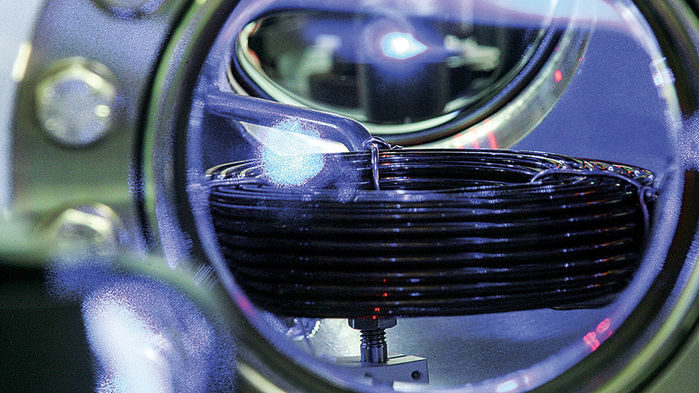
In a paper out last month, a group of experts set up by the International Bureau of Weights and Measures (BIPM) in Sèvres, France, lays out a road map for the steps needed to redefine the unit of time-the metric second-in terms of optical radiation. Already, physicists at the National Institute of Standards and Technology (NIST) Boulder Laboratories in Colorado appear to have satisfied one of the road map's key requirements-a 100-fold improvement in accuracy over the best microwave clocks-using a pair of optical clocks.
Clocks mark time by tracking a periodic action. A grandfather clock relies on the regular swings of a pendulum, and the original definition of the second was based on the length of a day as fixed by Earth's spin. Current atomic clocks depend on the oscillations of a microwave beam at the precise frequency needed to excite atoms of cesium-133 to a higher energy level. In 1967, the second was defined as 9,192,631,770 cycles of a beam tuned to the cesium standard. Today, the best cesium clocks have accuracies of 1.6 parts in 1016.
The frequency of visible light is about 100,000 times higher than that of microwaves, promising even more precision. However, the lasers needed to cool atoms and provide a stable reference at these frequencies are a challenge to build. Improvements in laser technology led BIPM a few years ago to begin reviewing the accuracy of optical clocks. On 14 February it published a paper in its journal, Metrologia, setting out five milestones that should be met before the second can be redefined based on visible light. And in unpublished work, Andrew Ludlow and colleagues at NIST appear to have reached the accuracy stipulated by BIPM's first milestone.
The NIST team operated two optical clocks, using several lasers to cool and trap a few thousand ytterbium atoms in an "optical lattice" and then excite a particular energy transition in those atoms. The researchers found that the two clocks ticked at the same rate to within 1.4 parts in 1018-just over 100 times better than the top cesium devices. "It would be the first time that two clocks of the same species have been shown to agree at that level," Ludlow says.
Being a cautious bunch, meteorologists will not accept the NIST result at face value. Jérôme Lodewyck, a physicist working on strontium lattice clocks at the Paris Observatory's Time-Space Reference Systems lab, says the NIST result "is probably correct," but that when it comes to changing the second, "probably correct is not good enough." He notes that something unexpected-perhaps a stray electric field-could throw off two clocks in the same lab by the same amount, making the drift undetectable.
The BIPM road map calls for a number of cross-checks, including reaching the required accuracy with clocks in different labs. Another check involves comparing the ticking of different types of atomic clocks. The NIST scientists and colleagues at JILA, a research institute down the road in Boulder, are doing just that, comparing the ytterbium clocks to others that rely on strontium atoms and aluminum ions. Ludlow says the measurements are not far off the desired accuracy, and that once they've finished they can compare their results with labs in Europe or Asia.
One issue the road map does not address, Ludlow says, is how to choose which atomic transition-and hence type of clock-will ultimately come to define the second. He prefers clocks made from lattices of neutral atoms because they need only run for a few hours before reaching their stated accuracy, whereas rival devices made from single trapped ions might need weeks to do that. But he acknowledges that the jury is still out. "Ion clocks have made great advances in the last decade and they keep getting better," he says.
Patrick Gill, a laser physicist at the National Physical Laboratory in Teddington, U.K., says the switch over to optical clocks shouldn't happen while they are all improving so quickly. He says that officials might agree on a new definition when the world's top meteorological body-the General Conference on Weights and Measures-meets in 2026. (The organization meets every 4 years and this year is expected to approve new definitions for four other metric base units: the kilogram, the ampere, the kelvin, and the mole.)
Ekkehard Peik, head of the time and frequency group at Germany's National Meteorology Institute in Braunschweig, is more cautious still. Arguing that cesium clocks are accurate enough for today's applications, he says a redefinition can probably wait until the early 2030s, offering more time for scientists to duke it out with competing clocks. Such rivalry, he says, "is what also drives progress and one should not be afraid of it."



Reader Comments
"fumblefingered fuckup who...."
Just too funny. I m keepin' that one.
Here griffin, feel free to serve
I bought my 2nd. (link in my comments)
Life is too short not to get the last laugh: 25 hilarious headstones
I hate to break it to you, but we're all going to kick the bucket one day. These people were aware of that fact and decided to get the last laugh and have it carved in stone (or marble, but let's...Joking/ Facetious throughout.
RC